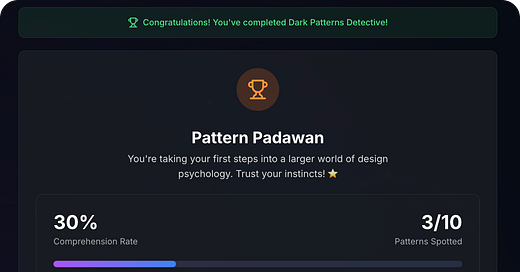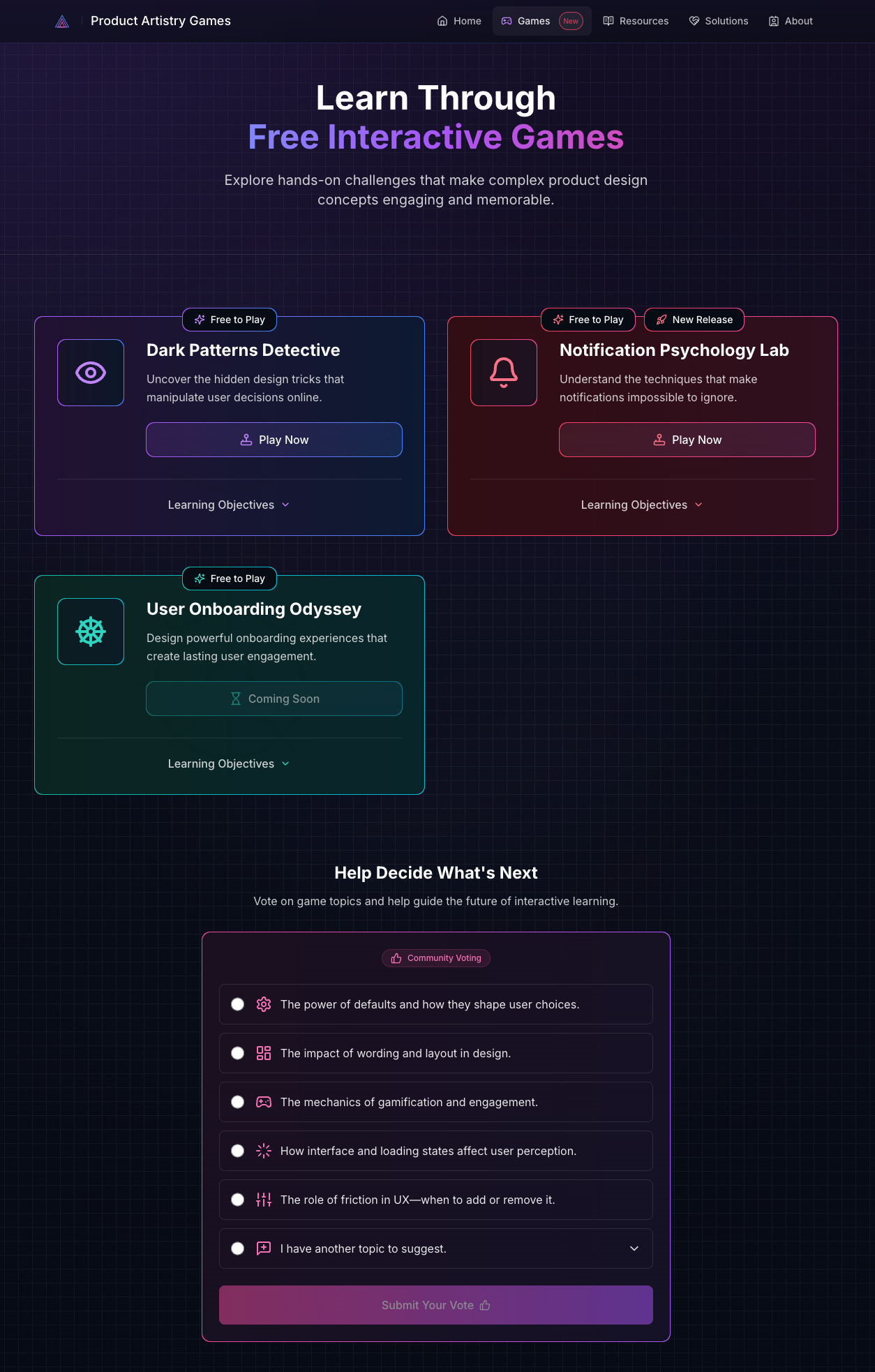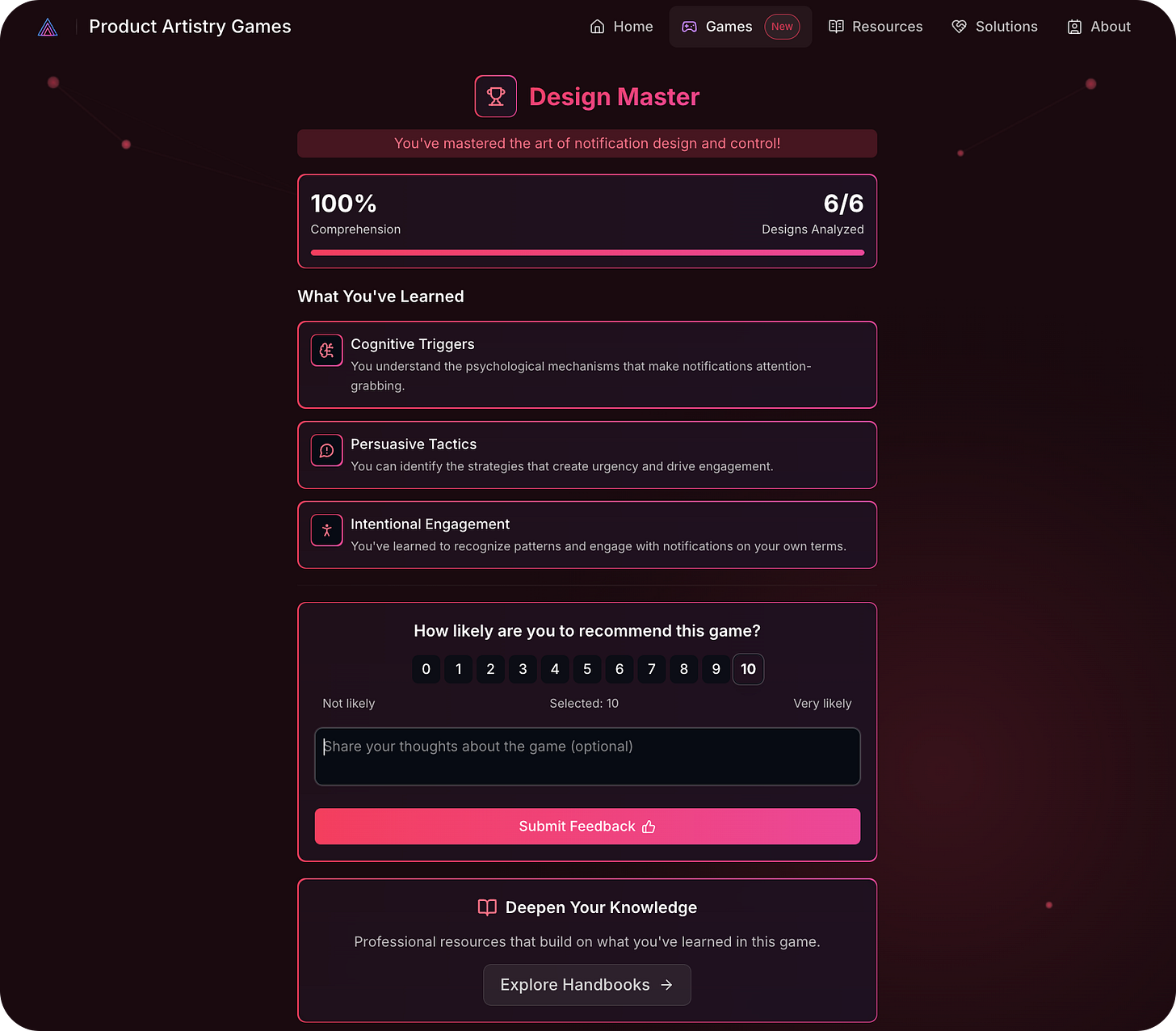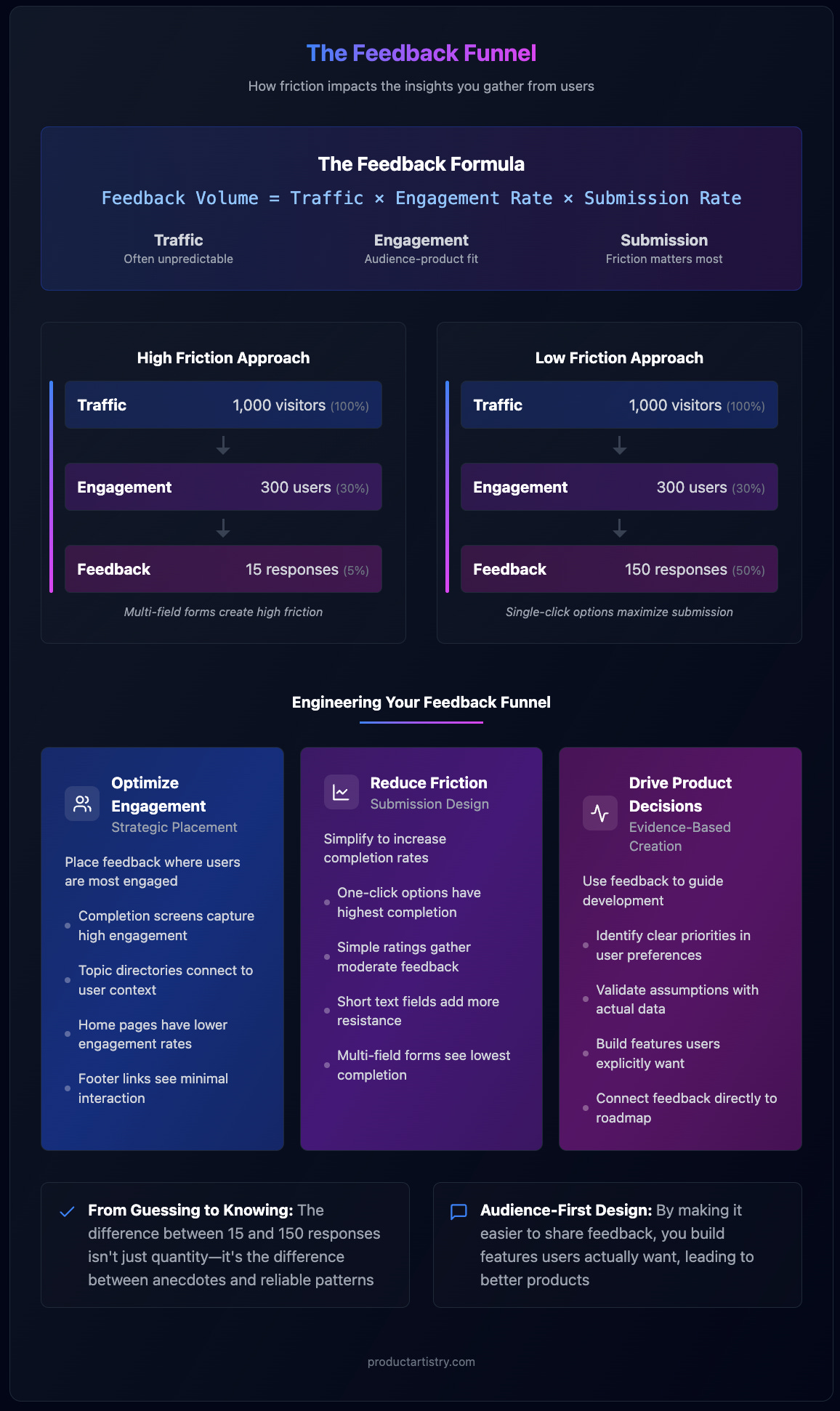What Going Viral Taught Me About User Feedback
How my feedback system evolved as my product grew—and why yours should too
When my game, Dark Patterns Detective, unexpectedly hit #5 on Hacker News, over 10,000 users flooded in nearly overnight.
What should have been a moment of celebration quickly turned into panic.
The surge brought an incredible wave of feedback—but I had no structured way to capture, analyze, or act on it beyond this moment. My fun experiment had suddenly become something real, with real expectations. And I wasn’t ready.
Like many creators, I had focused entirely on building the core experience, assuming I’d figure out feedback later. But when traction hit, my biggest regret wasn’t a lack of feedback—it was not having a system to make sense of it when it mattered most.
I wasn’t alone in this. Again and again, I’ve seen the same pattern:
The difference between products that thrive and those that fade often comes down to how well their creators capture and respond to feedback.
The biggest lesson I learned?
Your feedback system can’t be static—or an afterthought.
It needs to be baked into your product from the start—and ready to evolve.
At every stage of growth, you’ll face different questions that require different feedback approaches:
Validation → Will anyone use this at all?
Refinement → How can we improve the experience?
Direction → What should we build next?
Monetization → What would people pay for?
Growth → Would users recommend this to others?
Yet most MVPs rely on a single feedback method—if any—leading to either overwhelming complexity or oversimplified insights. Neither works.
Here’s how my approach to feedback evolved as my product grew—and why yours should too.
How My Feedback System Evolved
After Dark Patterns Detective gained traction, what started as a single-page app expanded into a broader platform: Product Artistry Games. This shift gave me more surface area for feedback touchpoints, allowing me to experiment with different methods of gathering user insights.
Stage 1: Basic Completion Tracking (Validation Stage)
Key Question: Is this engaging enough for people to finish?
At this stage, my only feedback mechanisms were:
A newsletter signup after game completion, signaling deeper interest.
A “Report a Bug” / “Get in Touch” button in the footer, which simply opened an email form.
The newsletter signups were an early signal of positive engagement, confirming that some players wanted to stay connected. However, beyond that, my system had gaps. The footer buttons were too high-friction, and sending an email was too much effort for casual feedback.
Strategic Touchpoint: Game completion page
Result: While the newsletter signups provided a proxy for interest, the most valuable insights during the traffic spike didn’t come from my system—they came from the Hacker News discussion.
Insight: When your product gets attention, users will talk about it where they already are—meet them there.
Stage 2: External Platform Feedback (Refinement Stage)
Key Question: How can I improve the experience and clarity of the game?
Hacker News had given me a firehose of feedback and surfaced critical feedback on game design and usability, shaping my first round of refinements—but it wasn’t scalable.
I needed a way to:
Capture structured feedback inside the game
Identify common pain points beyond early adopters
Understand which improvements would have the most impact
While platform discussions (Hacker News, Mastodon, LinkedIn) continued to be valuable, they weren’t enough. I needed a system for engaged players, not just one-time visitors.
Strategic Touchpoint: Embedded feedback mechanisms requirement
Insight: External platform feedback is great for identifying early refinements, but it won’t help answer strategic product decisions.
This realization led me to expand Product Artistry Games, giving me more room to test built-in feedback loops, as we’ll see in the next stages.
Stage 3: Direction Validation (Direction Stage)
Key Question: Do people want more—and if so, what topics specifically?
With Product Artistry Games, I had a dedicated space for interactive learning games. This gave me a structured environment to test more scalable feedback mechanisms.
I introduced a low-friction voting system on the main games page:
Simple, icon-driven choices
Single-click voting (no signup required)
Instant visual confirmation
Strategic Touchpoint: Main games directory page
Result: This mechanism generated nearly 100 votes, revealing two clear favorites in a classic Pareto distribution (80/20 rule).
Meanwhile, the higher-friction “Choose Other” dropdown saw little engagement—reinforcing the importance of keeping feedback simple.
Insight: The easier you make it to give feedback, the more responses you’ll get.
This insight became the foundation for how I would later test monetization options.
Stage 4: Value Proposition Exploration (Monetization Stage)
Key Question: What resources would people find valuable and potentially pay for?
Building on the success of the game voting system, I introduced a paid resources interest poll on my home page.
Strategic Touchpoint: Home page (lower section)
Result: Unlike the games page, this poll received almost no engagement.
Why?
Low visibility – The poll was buried too far down the page
Low urgency – Users weren’t thinking about paid content yet
Too broad – The options weren’t specific enough
Casual Visitors vs. Core Audience – Most users were just exploring, not actively looking for solutions
While this confirmed that some interest existed, it wasn’t actionable. I’ve since removed this poll and plan to reintroduce it in a more targeted, visible touchpoint.
Insight: Just because a feedback method works in one context doesn’t mean it will work everywhere.
Stage 5: Referral and Satisfaction Measurement (Growth Stage)
Key Question: Would people recommend this game to others?
With a growing player base, I needed a scalable way to measure user satisfaction. Before launching my second game, I introduced a Net Promoter Score (NPS) survey on the completion screen:
Standard 0-10 rating scale
Optional open-ended feedback field
Reusable across future games
Strategic Touchpoint: Game completion screen
Result: The initial NPS for Dark Patterns Detective was 65+, indicating strong user satisfaction and providing a benchmark for future products.
Unlike unstructured feedback, this approach let me track trends over time and compare satisfaction levels across different releases.
Insight: Pairing a lightweight metric with optional open-ended feedback struck the right balance. The structured rating ensured a high response rate, while the optional text field let engaged users share deeper insights.
A Simple Approach to Effective Feedback
Through my journey with Product Artistry Games, I’ve distilled three core principles for designing effective feedback systems. The key is ensuring that feedback is:
Targeted – Focused on the right question at the right time.
Easy to Give – Low-friction, encouraging higher participation.
Captured at the Right Moments – Embedded naturally into the user experience.
1. Start with Your Most Important Question
Every stage of growth presents a different uncertainty. Instead of collecting broad, unfocused feedback, pinpoint the single question that, once answered, will clarify your next steps.
Examples:
Early validation: Will people finish this game?
After going viral: What topic should I tackle next?
With an established audience: Will users pay for premium content?
Without a clear focus, feedback becomes scattered and ineffective.
Action Step: Before adding any feedback mechanism, ask:
"What is the one insight I need most right now?"
Then design your system around that.
2. Keep Feedback Mechanisms Simple
The more effort it takes to provide feedback, the fewer responses you’ll get. Simpler methods increase participation, while complex forms discourage engagement.
Friction Spectrum:
One-click feedback → Baseline participation
One-click with optional follow-up → Captures deeper insights while keeping participation high
Short forms (2-3 fields) → Requires effort, leading to fewer responses
Longer forms → Highest friction, minimal engagement
Even small increases in effort drastically reduce participation. However, bundling an optional follow-up with a low-friction action—like adding a comment field to an NPS survey—can capture richer insights without deterring users.
Action Step: For every feedback mechanism, ask:
"What’s the absolute simplest way to collect this insight?"
Then strip away unnecessary steps—or bundle follow-ups into low-friction interactions.
3. Capture Feedback at the Right Moment
When and where you ask for feedback is just as important as how you ask.
Your feedback prompts should:
Appear at moments of peak engagement
Align naturally with what users are already thinking about
Minimize disruption to the user’s flow
Examples of well-timed feedback:
Game completion pages → Great for gathering insights when users are most engaged
Game directories → Work well for quick directional voting
Monetization surveys → Must be highly visible and shown when users are already considering purchases
Poorly timed or misplaced feedback requests lower response rates and reduce data quality.
Action Step: Map your user journey and place feedback prompts strategically at high-engagement moments that align with user intent.
The Feedback Funnel Formula
As my product evolved, I started thinking about feedback as a simple equation:
Feedback Volume = Traffic × Engagement Rate × Feedback Submission Rate
Each factor represents a lever you can influence:
Traffic → The number of visitors coming to your product. Essential but often unpredictable, especially for indie projects. This is the widest part of the funnel.
Engagement Rate → The proportion of visitors who are genuinely interested and interacting meaningfully. Driven by clear value proposition and audience-product fit. This is the middle of the funnel.
Submission Rate → The percentage of engaged users who complete feedback requests. This is where friction plays the biggest role. The narrowest part of the funnel, and where thoughtful feedback design makes the biggest difference.
By improving these three levers, you can increase both the quality and quantity of feedback, leading to better decisions and a more audience-driven product.
Putting This Into Practice
To show how different feedback approaches affect what you learn, here’s a simple comparison of high-friction vs. low-friction systems.
Example: High vs. Low Friction Feedback Systems
Imagine a product with 1,000 monthly visitors:
Traffic → 1,000 visitors enter the top of the funnel.
Engagement → 30% are genuinely engaged → 300 users.
Submission Rate:
A multi-field form (high friction) might get a 5% submission rate → 15 responses.
A single-click mechanism (low friction) might get a 50% submission rate → 150 responses.
The difference between 15 and 150 responses is massive—it separates anecdotal data from clear, actionable patterns.
With only 15 responses, it’s hard to detect meaningful trends.
At 150 responses, patterns emerge, making it far easier to make evidence-driven decisions.
Engineering My Feedback Funnel
This mental model led me to systematically improve each stage of my feedback funnel:
For engagement → Placed feedback mechanisms at high-engagement moments and context-appropriate touchpoints.
For submission → Reduced friction to maximize response rates.
For overall volume → Optimized for participation and clarity, ensuring that even with lower traffic periods, I still received meaningful insights.
Why This Approach Works
By making it easier for users to share their preferences, I build features they actually want—leading to higher engagement and better products.
Instead of guessing what might resonate, I now have direct channels to understand what my audience values.
The feedback funnel isn’t just a measurement tool—it’s a framework for prioritizing improvements at each stage of product growth.
Conclusion
Effective product development isn’t about answering every possible question at once—it’s about identifying the specific uncertainty holding you back and designing the simplest feedback mechanism to resolve it.
A static feedback system won’t keep up with a growing product. As your audience evolves, your approach to gathering insights must evolve with it.
Don’t wait until users arrive—build adaptive, lightweight feedback loops from day one.
Speed alone isn’t a competitive advantage anymore. Learning fast is. And that starts with asking the right questions, in the right places, at the right times.
Keep iterating,
—Rohan
→ Connect with me on LinkedIn.
Thanks for reading! If you’ve found this post valuable, here’s how you can show your support:
Like and Share: Spread these ideas to others who they may resonate with.
Become a Paid Subscriber: Help support my work and mission.
P.S. I have two exciting announcements since my last post:
🎮 New Game: Notification Psychology Lab – Explore the psychology behind effective notifications through interactive play. Play Free Now →
📚 New Resource: Dark Patterns Handbook – Designed as a companion to my game, Dark Patterns Detective, this comprehensive Notion handbook takes those concepts deeper with practical frameworks and implementation guides. Free bonus for Paid Subscribers!
Still here? I’d appreciate you taking a second to answer this quick poll for feedback:










Super interesting - fiddled around with it , curious what your goal with this project?